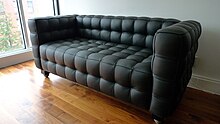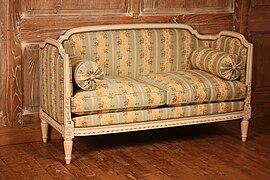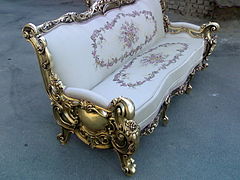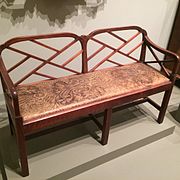Settee
Etymology
The term couch originally denoted an item of furniture for lying or sleeping on. Couch is predominantly used in North America, Australia, South Africa, and Ireland, whereas the terms sofa and settee (U and non-U) are most commonly used in the United Kingdom and India. The word couch originated in Middle English from the Old French noun couche, which derived from the verb meaning "to lie down".
The word sofa comes from the Turkish language and is derived from the Arabic word suffah ("ledge/bench"), cognates with the Aramaic word sippa ("mat"). Nathan Bailey in his Dictionarium Britannicum (1730) defines sofa as a "a sort of alcove much used in Asia ... furnished with rich carpets and cushions."
The word settee or setee comes from the Old English word setl, which was used to describe long benches with high backs and arms, but is now generally used to describe small upholstered seating structures. Both "sofa" and "settee" terms came into use in the beginning of the 18th century. Originally the settee defined a smaller sofa, but by the 20th century the distinction was lost.
Other terms which can be synonymous with the above definition are divan, davenport, lounge, and canapé. In Canadian English, the word chesterfield is used to describe any couch or sofa, particularly among older Canadians. According to a 1992 survey conducted in the Golden Horseshoe region of Ontario, the term is quickly vanishing.
Types


The most common types of couches include the two-seater, sometimes referred to as a loveseat, and the sofa. The loveseat is designed for seating two people, while the sofa has more than two cushion seats. A sectional sofa, often just referred to as a "sectional", is formed from multiple sections (typically two, three, or four) and usually includes at least two pieces which join at an angle of 90 degrees or slightly greater. Sectional sofas are used to wrap around walls or other furniture.
Other variants include the divan, the fainting couch (backless or partial-backed) and the canapé (an ornamental three-seater). To conserve space, some sofas double as beds in the form of sofa beds, daybeds, or futons.

A furniture set consisting of a sofa with two matching chairs is known as a "chesterfield suite" or "living-room suite". In the UK, the word chesterfield was used to refer to any couch in the 1900s. A chesterfield now describes a deep buttoned sofa, usually made from leather, with arms and back of the same height. The first chesterfield, with its distinctive deep buttoned, quilted (or "tufted") leather upholstery and lower seat base, was commissioned by Philip Stanhope, 4th Earl of Chesterfield (1694–1773).
Materials
A couch consists of a frame, springs, padding, and a covering. The frame is usually made of wood, but can also be made of steel, plastic or laminated boards. Sofa padding is made from foam, down, feathers, fabric or a combination thereof. Sofa coverings are usually made out of soft leather, corduroy or linen. Couches commonly have springs under the padding for more support, although some don't.
Image gallery
-
A two-seater upholstered loveseat
-
A leather couch
-
Sofa steel production malayer
-
An upholstered couch
-
English Settee, c. 1770
-
Roman style couch for reclining
See also
- Bean bag chair
- Chaise longue, a similar elongated piece intended for a single person
- Couch potato
- Davenport (sofa)
- Divan (furniture)
- Klippan (sofa)
- Ottoman (furniture)
- Settle (furniture), wooden furniture with similar usage
- Slipcover
- Wing chair
- Window seat (type of sofa)
Citations
- ^ "Couch". Dictionary.com (American Heritage Dictionary). Retrieved 2012-08-15.
- ^ "Couch". The Free Dictionary By Farlex. Retrieved 2012-05-12.
- ^ "Couch". Merriam-Webster. Retrieved 2012-05-12.
- ^ Harrison, Molly (1971). People and furniture: a social background to the English home. Ernest Benn. p. 55. ISBN 978-0-8747-10373.
- ^ Lennox, Doug (2007). "Home, Hearth, and Family". Now You Know Big Book of Answers. Dundurn. ISBN 978-1-55002-741-9. Retrieved June 20, 2018 – via Google Books.
- ^ "couch noun". Oxford Collocations Dictionary. Retrieved June 19, 2020.
- ^ AMHER, couch: Middle English from Old French culche, couche > couchier, coucher.
- ^ "sofa", Wiktionary, 2022-07-03, retrieved 2022-07-06
- ^ "sofa | Etymology, origin and meaning of sofa by etymonline". www.etymonline.com. Retrieved 2022-07-06.
- ^ "Definition of SOFA". www.merriam-webster.com. Retrieved 2022-07-06.
- ^ "Sofa, Couch or Settee: The History Of Where Each Word Came From". 18 October 2018.
- ^ AMHER, sofa: Turkish, from Arabic suffah, from Aramaic sippa, sippəta.
- ^ Gloag & Edwards 1991, p. 597, Settee.
- ^ "Definition of settee | Dictionary.com". www.dictionary.com. Retrieved 2020-10-02.
- ^ Barber, Katherine, ed. (2004). Canadian Oxford Dictionary (Second ed.). Oxford University Press. p. 264. ISBN 978-0-19-541816-3.
any couch or sofa
- ^ Chambers, J. K. "The Canada-U.S. border as a vanishing isogloss: the evidence of chesterfield". Journal of English Linguistics; 23 (1995): 156–66, excerpt at chass.utoronto.ca Archived 2007-09-12 at the Wayback Machine.
- ^ "Three-piece-suite". Cambridge Dictionaries Online. Retrieved 2012-05-12.
- ^ "Chesterfield suite". Merriam-Webster. Retrieved 2012-05-12.
- ^ "Living room suite". Cambridge Dictionaries Online. Retrieved 2012-05-12.
- ^ Wade, Olin (2022-07-24). "What is the purpose of tufting?". www.remodelormove.com. Retrieved 2024-08-04.
- ^ Kramer, Jennifer. "How products are made". encyclopedia.com. Retrieved 22 June 2022.
General and cited references
- Gloag, John; Edwards, Clive (1991). A Complete Dictionary of Furniture. Woodstock, N.Y: Overlook Books. ISBN 0-87951-414-0.
Further reading
- Campbell, Gordon (2006). "Sofa". The Grove Encyclopedia of Decorative Arts. Vol. 2. Oxford University Press. p. 369. ISBN 978-0-19-518948-3.
External links
 The dictionary definition of couch at Wiktionary
The dictionary definition of couch at Wiktionary





